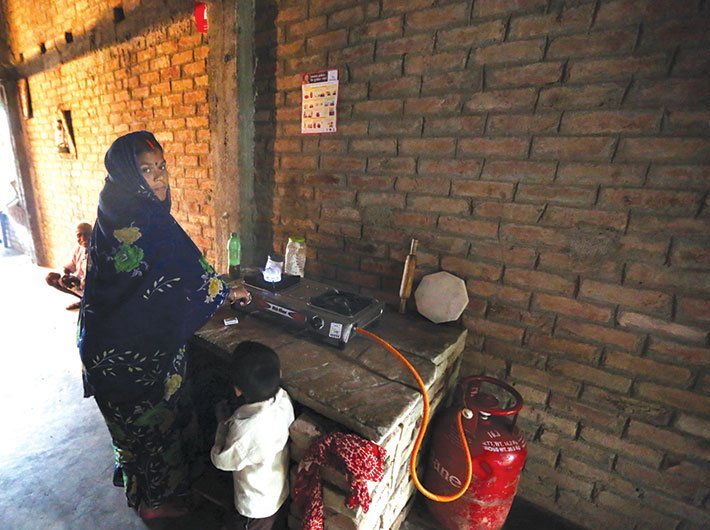More than 80% of the rural population in India depends on traditional fuels like firewood, crop residue, cow dung and lignite
One shortcoming of the schemes for fuel for cooking in rural areas is “they do not take into account the gender aspect of access to clean energy”, noted a Niti Aayog blog.
Simi Thambi, a young professional at Niti Aayog, wrote in her blog “Access to Clean Cooking for Rural Women: Food for Thought” that in rural houses where men are sole decision makers and breadwinners, it could be tough to switch to cleaner fuels. To facilitate a holistic understanding of access to clean energy for cooking problem, there needs to be a platform where Ministries of Energy, Ministry of Women and Child Development and Ministry of Health interact to arrive at an integrated solution to address this problem.
She said that a system needs to be created where the village level ASHA workers also take the responsibility of creating awareness about the ill effects of traditional chullah. This will create a bottom- up demand for cleaner fuels.
NITI Aayog, in its new avatar, can play an exceptional role to create such a platform. Its capacity to coordinate and engage with ministries and different stakeholders gives it a unique strength. It can develop an integrated clean cooking policy that looks at the problem from multiple dimensions – health, gender, and energy. An integrated plan like this will indeed go a long way in freeing our rural women from the bondage of soot emitting traditional chullah. Hopefully, the National Energy Policy being mooted by NITI Aayog may propose a way forward on this vital issue.
Thambi says that clean cooking continues to be a luxury for rural women. While several efforts have been made to address this issue most notable of these being the Prime Minister Ujjwala Yojana that involves giving LPG connections to poor women residing in rural areas, there is a general opinion among field activists and think tanks studying this issue, that much more needs to done. Energy access is not a binary problem that can be resolved by ensuring whether a household has LPG/ electricity connection or not. It is rather a multidimensional problem that goes beyond looking at connection as a solution.
More than 80% of the rural population in India depends on traditional fuels like firewood, crop residue, cow dung and lignite (Census 2011). The use of traditional fuels for cooking on a chullah leads to indoor air pollution. It emits black carbon and PM 2.5 that have adverse health impacts. Women and children, who spend most of their time in the close vicinity of the cooking area, are most susceptible to this pollution. The WHO estimates 500,000 deaths per year in India due to indoor air pollution.
Recognising this issue as a problem, LPG has been aggressively promoted by the government as an alternative to tradition fuels. Ministry of Petroleum and Natural Gas (MoPNG) has three schemes to do this, Rajiv Gandhi Gramin LPG Vitran Yojana, Pradhan Mantri Ujjwala Yojana and PAHAL Scheme. As a result, the country has seen an unprecedented increase in the number of domestic LPG connections in the last decade. India currently has about 190 million LPG connections for its 260 million households.
While these efforts are truly commendable, relying only on LPG as the major policy intervention is insufficient. Several research studies based on field surveys point out important realities in this respect. For instance, having an LPG connection does not necessarily translate into its sustained use for cooking. Although the installation of LPG has been made easy because of its subsidization under several government schemes, monthly refill of the cylinder continues to be a problem.
The blog says that not only due to the monetary cost of refill but also due to the arduous task of lugging the cylinder to the nearest refill station particularly in tough terrain. In areas that show 100% connection under the Ujjwala scheme, only around 50% use the LPG connection regularly. Though it is acknowledged that the scheme is in its early days, with time considerable improvements can be expected. There is thus a need to differentiate between connection and use. Many suggestions exist, including development of LPG cylinders in different portable sizes to address this problem.
Nevertheless, relying on LPG as a main solution to energy access is not sustainable. India is heavily dependent on petroleum imports to meet its domestic requirements. Increased domestic use of imported petroleum will result in a high import bill.
As an alternate solution, the government has also promoted the use of renewable energy. Ministry of New and Renewable Energy (MNRE) has a National Biomass Cook Stove Programme that aims to promote deployment of improved cooked stoves to households. Improved cook stoves that use biogas present a great opportunity for clean cooking. In fact, in states that have an abundance of biomass due to their livestock, rather than LPG replacing biomass, it should be biomass replacing LPG. However, the cost of supplying a clean cost effective cook stove is high. This is where R&D can prove beneficial. Another initiative of the MNRE was the community-based biogas plants launched in the 1980s.
Another possible alternative is using power for clean cooking in rural areas. Village electrification program of the Ministry of Power aims to provide universal access to electricity by extending the grid even to remote regions. Electricity can be used for cooking using induction stoves. If however, this power is generated using fossil fuels rather than renewable energy, its cleanliness is questionable. It is also important to note that supply of electricity without quality makes it of limited use for productive purposes.


